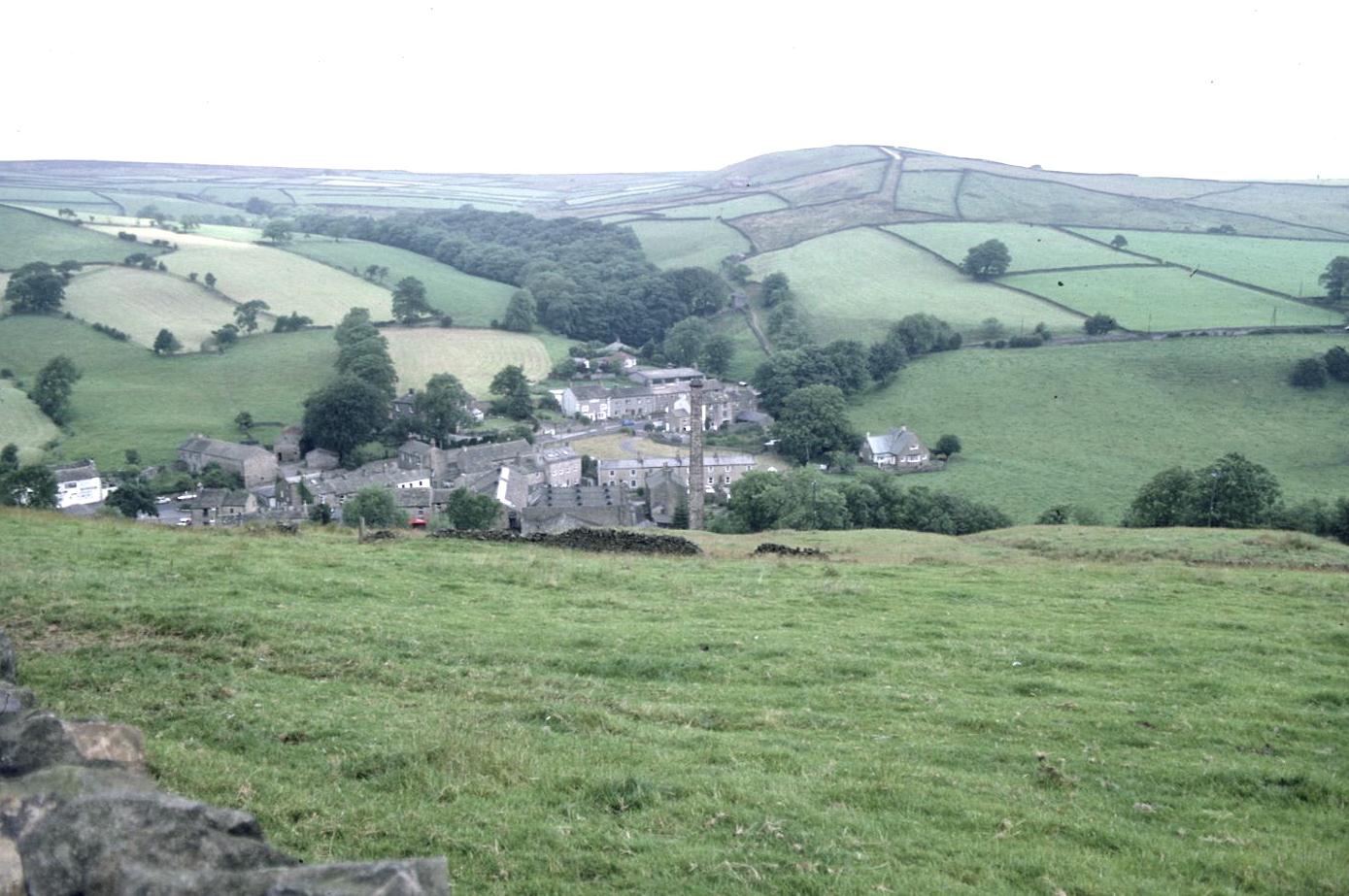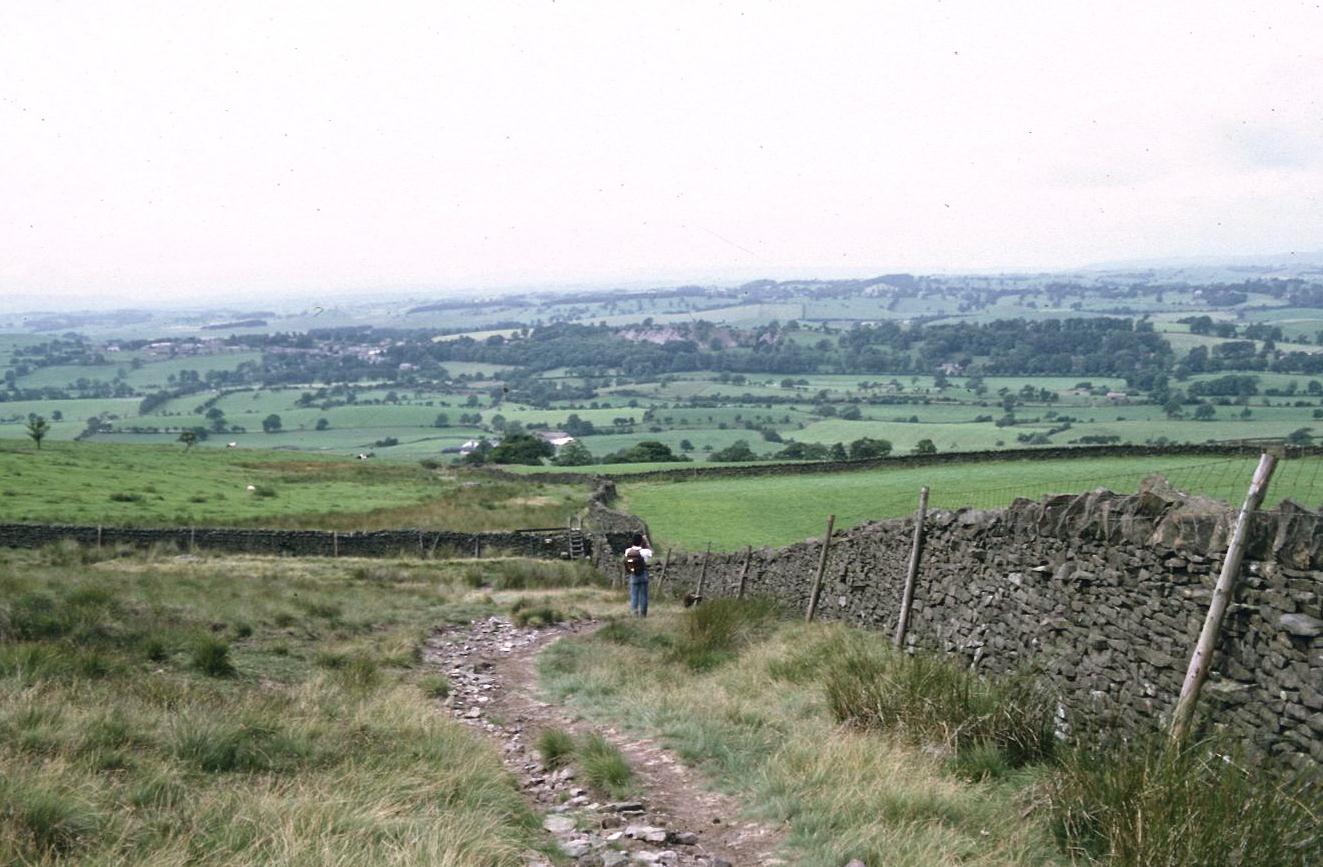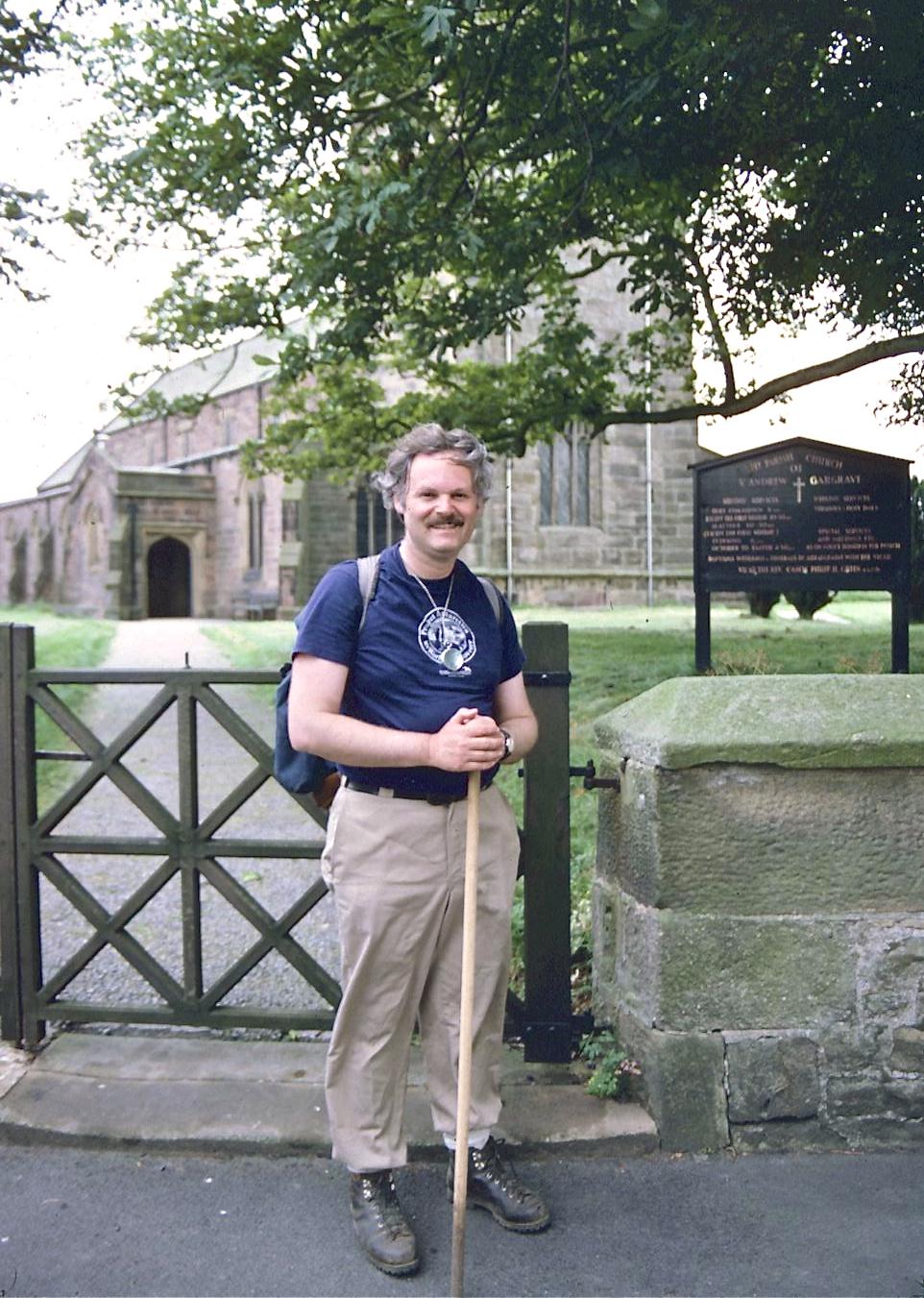July 25, 1982: Ponden Hall to Gargrave
Mrs. Taylor had promised us an early 7:45 breakfast and by 8:15 we were ready to depart. I wanted an early start for there remained another seventeen-mile day ahead of us – one that would be my last day on the Pennine Way.
We had three major ridges to cross today, but the weather was again cooperating, for it was pleasant and mostly sunny: five days of walking and the raingear not on once! The first ascent from the floor of the valley of the River Worth was the steepest – but not a patch on our climb from the River Calder. We played the last variation in our verbal game – name the town in which everybody bends with the times: Plasti City; the town whose water supply is poisoned: Toxi City; a town full of fat people: Obe City.
Having reached the top of Dean Clough Woods we spent a little time searching for a continuation of the PW but we were correct in our assumptions, and soon we were undertaking an easy ramble through the heather near Wolf Stones and making a quick ascent of Ickornshaw Moor. Once again his followers had proved Wainwright wrong by creating a path where he had seen only a trackless (and often peaty) slope. Peat was being cut for fuel near the bottom. We walked on some farm lanes and even got directions from a little boy on a bicycle at Lower Summer House Farm. We were hours too early for the Back Bull Inn at Ickornshaw, where a number of changes seem to have taken place in the route since Wainwright had completed his guide. We got a bit lost on the back streets and had to get directions from a surly chap tinkering with his car in a driveway. I used the local gents.
After leaving Ickornshaw I noticed that we seemed to be heading to the west of Middleton, a surprise, but I was relieved to see the route join Gill Lane soon thereafter. At Gill Beck we began our second major ascent – this time through farmyards in the warm sun – reaching the 1000-foot mark on Cowling Hill, where we paused to share a Coke amid curious black and white cows. The wildflowers were in wonderful bloom hereabouts. A steep descent on a tarmac road brought us down to Surgill Beck and after climbing past Wood Head Farm we had our first view of Lothersdale below and, more specifically, of the Hare and Hounds pub.
Another descent brought us into the village, but a local yobbo could only tell us that the pub opened at “dinner time.” It was five to 12:00 and we decided to wait in the parking lot. At 12:00 exactly we were ushered in (boots off again a requirement) and I had a pint of lager while Jay experimented with a pint of cider. The rest of the walkers from Ponden Hall soon arrived as well. They served sandwiches at this pub but we were still intent on using up the last of the food in our packs. The landlady told Jay to take his sore feet off an empty footstool. We stayed only half an hour, as I was hoping to make a 5:00 bus from Gargrave. Soon after leaving the pub we met the two girls from Doncaster for the last time.
Another major ascent, at first through farm fields, then on farm roads, and finally on heather moor path brought us easily to the summit of Pinhow Beacon – the last major elevation rise of the trip. From here we could see the valley below and Thornton-in-Craven specifically. We made quick progress off the summit, through some wet ground, and among farmyards – where route finding was a little more difficult. When we struggled back up to Thornton we paused to drink a ginger beer in the shade of a linden tree next to the A56.
Then it was along Cam Lane, past flowering cottages, to the open countryside – the gentle ups and downs of the green fields reminded me so much of the country I had encountered on my first day in the Pennines. I could see we were picking up time now, and, only four miles from our goal, I began to feel very regretful that my mission was so near its end.
At the top of Langber Hill we encountered the Leeds and Liverpool Canal, full of boats and Sunday trippers. We walked along the towpath as far as East Marton, then detoured through this village, including its churchyard. We returned to open country soon thereafter, with many delightful views and a sky that was becoming more ominously grey in the west. As we crossed Scaleber Hill and had our last rest, we could see Gargave off in the distance and a few minutes later, at 4:30 on July 25, 1982 and on my sixth trip and twenty-first day of walking this route, I reached a corner where the road returned to the Gargrave station and by so doing I wearily, happily, regretfully, completed the Pennine Way.
Jay took my picture in front of the church and I finished a roll with shots of my faithful Indian companion at a sidewalk table in front of the Dalesman Café – which proved to be the very spot where our bus to Skipton would stop. We had half an hour and ordered Cokes, but not before the landlady had interrogated us on the subject of Ronald Reagan. “We think he stands shoulder to shoulder with our Margaret Thatcher, a grand woman who’s doing her best to turn this country around and rescue it from the lazy good-for-nothing socialists who think nobody should be required to work. What do you say?” she asked. “We work,” was my only response. Muttering imprecations against Michael Foot and Arthur Scargill she took her red cheeks back into her store and let her daughter get on with serving us. The latter also brought us a PW book to sign. All in all, I would have preferred a pint at the Border Hotel.
The bus driver gave us directions for reaching the railroad station in Skipton via a back route, but we had to ask several passersby to repeat these before we were successful. A BR workman summoned the station master when I said I wanted to buy tickets, but the latter informed me that the 5:13 hadn’t run in three months and even with the 6:54 to Leeds I couldn’t get to London tonight. “Yes, I can,” I said, insisting with such certainty that this lord of the files had to retreat to his timetables. “Oh yes,” he discovered at last, “change at Leeds for Doncaster and at Doncaster for Kings Cross. You can be in London at 11:05 tonight.”
We had an hour to kill and on our sore feet we walked back into Skipton. I bought fish and chips for us but was told I couldn’t sit down without paying 15% VAT. So we sat on some benches on the main drag and observed the typical British scene for 1982, hundreds of Sunday strollers and not a shop open to serve them. It was time to have a last look at the Sylko Thread factory and the Midland Hotel, where I had spent my first Pennine night in 1974. It didn’t seem as if eight years had passed.
After the milk run to Leeds we had a pint in the station bar amid drunken Irishmen who were worried about adders on their favorite golf courses. They wanted us to sing them a chorus of the “Happy Wanderer.” The shuttle train to Darlington was so crowded with Rolling Stones fans that we had to sit with a mob on the floor of the guard’s van, an empty car manned by India’s answer to Terry-Thomas, a poor chap who was utterly overawed by the crush. This was surely a unique British Rail journey for me. At last I felt like a true refugee.
There were plenty of seats on the London train, which we picked up at Doncaster, but unfortunately we were in a car with a dozen high school students from Texas; they shrieked enthusiasms for hours. Worse was their counselor, who wanted to interrogate Jay and me on the state of Michigan State. Jay simply refused to talk to him.
We arrived on time and were soon on the Bakerloo Line, once more among the urban loonies after a week among their country cousins. It had been a great trip, which came to an end at 11:30 and, with it, the last entry in my PW journal.
For those of you are continuing on from Gargrave you need:
Footpath Index:
England: A Chilterns Hundred | The Chiltern Way | The Cleveland Way | The Coast-to-Coast Path | The Coleridge Way | The Cotswold Way | The Cumberland Way | The Cumbria Way | The Dales Way | The Furness Way | The Green London Way | The Greensand Way | The Isle of Wight Coast Path | The London Countryway | The London Outer Orbital Path | The Norfolk Coast Path | The North Downs Way | The Northumberland Coast Path | The Peddars Way | The Pennine Way | The Ridgeway Path | The Roman Way | The Saxon Shore Way | The South Downs Way | The South West Coast Path | The Thames Path | The Two Moors Way | The Vanguard Way | The Wealdway | The Westmorland Way | The White Peak Way | The Yorkshire Wolds Way
Ireland: The Dingle Way | The Wicklow Way
Scotland: The Great Glen Way | The Rob Roy Way | The Speyside Way | The West Highland Way
Wales: Glyndwr’s Way | Offa’s Dyke Path
Channel Islands: The Guernsey Coastal Walk | The Jersey Coastal Walk



